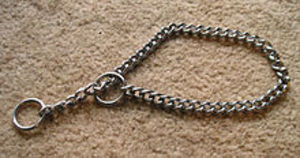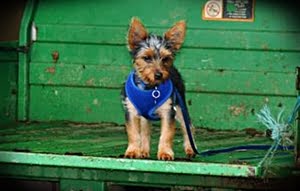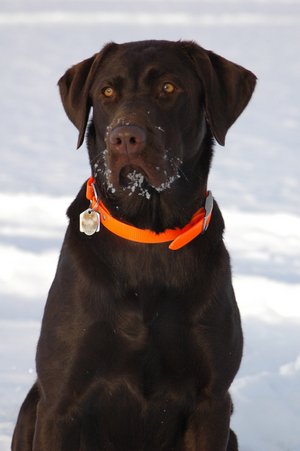For the average dog owner, the best time to use a choke collar is never. Just take these torture devices and toss them in the garbage. They get their name for a good reason — when pulled, they do choke the dog. But not only that, they also can do severe damage to a dog’s spine, windpipe, esophagus and nerves around the neck area.
Choke collars (or slip collars) should only be used by professional dog trainers to handle extremely hard to control dogs for short term use only. Choke collars may have to be used by animal control officers trying to remove dogs from dangerous situations and the dog refuses to cooperate. Otherwise, choke collars have no place on a dog’s neck.
Why They Don’t Work
Choke collars get a dog’s attention by inflicting pain. However, over time, dogs tend to ignore this pain and do what they want, anyway. Choke collars are no shortcut to good training – no matter what Barbara Woodhouse or Caesar Milan says.
Many people place choke collars on their dogs when going for walks. The excuse is that the dog pulls. This is no excuse to inflict pain on the dog. There are many other ways to encourage a dog not to pull. Play with the dog for ten or fifteen minutes before the walk. This burns off excess energy. Use a chest harness instead of a neck collar on the career puller. In this way, you won’t have to worry about collapsed tracheas or other neck damage.
About Pullers
It’s no crime if the dog walks ahead of you — unless you are in a dog show. But the average dog owner does not compete his or her dog. If the dog walks ahead of you, fine. If the dog walks ahead to the point where your shoulder hurts, not fine. Slam on the brakes. Do not move until the dog stands still and looks back at you. This process takes time.
Another way that pullers have been helped is for the puller to be walked with a dog that doesn’t pull. Make sure these two dogs are friendly. The pulling dog tends to want to be with his friend and will not have the urge to gallop away. If the dog begins to pull, the non-pulling dog should stop and then the walker of the pulling dog stops. No one moves on until the pulling dog is still.
Absolute Nevers
Perhaps there’s an emergency and all of your dog’s collars are missing and the only collar that you can quickly borrow is a choke chain. (Hey — it could happen). Do not tie the dog up with the choke chain because he will get himself hurt. Do not let the dog sleep with the coke chain on because accidents happen.
A good make-shift collar is a clip lead around the dog’s neck or even a piece of rope with a loop for the lead. But get a proper collar and lead as soon as possible.
References:
Vet Info.com. “Understanding Dog Collar Training Injuries.” http://www.vetinfo.com/dog-training-collar.html
Positive Dog Training.org. “Dog Training Choke Collar.” http://www.positivedogtraining.org/article/dog-training-choke-collar/
Various articles. “Your Dog” magazine 10th anniversary issue.





